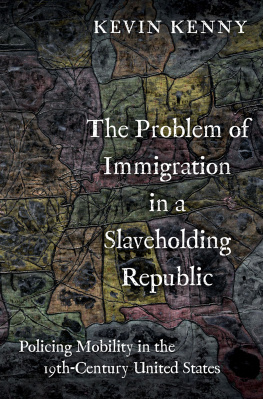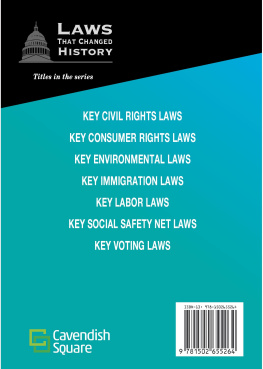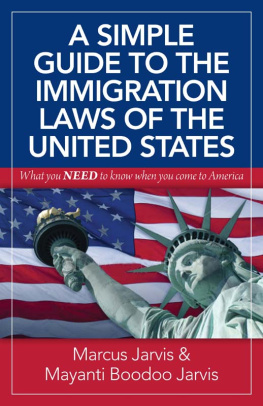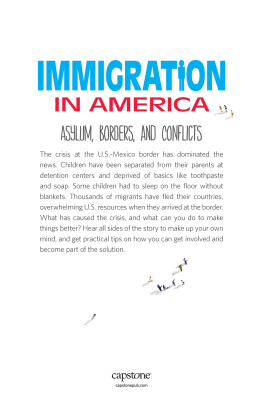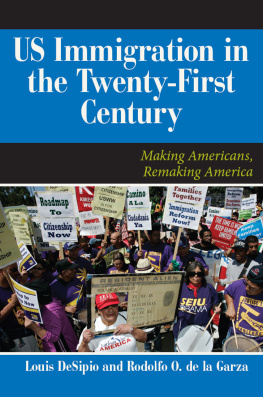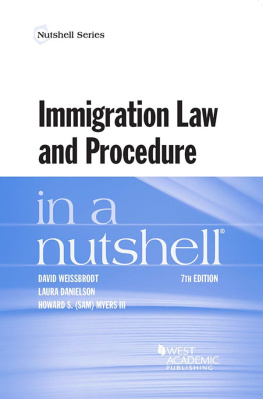
MIGRATING TO PRISON
MIGRATING TO PRISON
Americas Obsession with Locking Up Immigrants
CSAR CUAUHTMOC GARCA HERNNDEZ

Para Jess Mara Garca, que en paz descanse, y Eufrocina H. Garca
I know that what I am asking is impossible. But in our time, as in every time, the impossible is the least that one can demand
James Baldwin
CONTENTS
MIGRATING TO PRISON
INTRODUCTION
B y the time Diego Rivera Osorio was three years old he was already a veteran of immigration prisons. He had spent most of his life locked inside the Berks Family Residential Center, or baby jail, as critics call the one-hundred-bed facility northwest of Philadelphia where Immigration and Customs Enforcement (ICE) confines mothers and their children. Two years earlier, Diegos mother, Wendy Osorio Martinez, had fled threats of kidnapping and assault in Honduras, bringing Diego with her to seek asylum in the United States. We came here because the United States is safe. It has laws, Wendy said. But on crossing the Mexican border in 2015, they were caught by Border Patrol agents and sent to the Berks facility.
An hour away, Judge Walter Durling heard the deportation cases of many Berks families in the York, Pennsylvania, immigration court. A former Marine and government lawyer, Judge Durling was no bleeding heart. He denied three-quarters of all asylum applications he decided, well above the 57 percent national average. Over a period of two years, Judge Durling saw Diego on his docket sheet several times, and even to him, Diego was a different story. Diego, the judge wrote in August 2017, has gone from diapers to detention in his young life with no understanding or exposure to life beyond secure custody. In that time, Diego had won a special visa for children, but the federal government didnt relent, and it still tried to deport him. With the help of pro bono lawyers, he resisted long enough for a federal appeals court to take his side.application was turned down. Fearing return to Honduras, she continued asking courts to reconsider.
While the wheels of justice slowly turned, Diego and Wendy remained in Berks until, finally, Judge Durling ordered their release, noting that, in his short life, Diego had spent 650 days in jail with no end in sight. That night, sitting inside a Mexican restaurant at a table so high he could barely reach the food, Diego ate the first meal outside Berks that he could remember. Now mother and child live with a relative in Houston, waiting for the courts to decide their fate.
Diegos situation is alarming, but its not unique.
I grew up in South Texas, four hours south of San Antonio in the southeast corner of the state, where the Rio Grande meets the Gulf of Mexico. Its hot, poor, and overwhelmingly Mexican, and in the 1980s it was a hub for newly arrived migrants. In particular, Central Americans fleeing civil wars made their way to the Rio Grande Valley by the tens of thousands. Working with Congress, the Reagan administration responded with money, federal law enforcement officers, and immigration prisons. The Valley became an immigration battleground.
In the farmworker housing project where my family lived, Reagan administration directives were not distant policy debates. They were life-and-death developments about people we knew: relatives, friends, friends of friends. As a child, I experienced the rise of a security-focused immigration policy mostly through overhearing adult conversations. Sometimes it took the form of a to, an uncle, sleeping on a couch as he rested on his way up north. Other times it was my parents worrying about whether my grandfathers English was good enough to get him across the border. In the days before passports were required to get into the United States, his U.S. citizenship didnt guarantee he could return.
By the time I was a newly minted lawyer, I thought I was familiar with the regions role in the story of U.S. immigration, but it wasnt until I drove down Farm-to-Market Road 510 for the first time that I entered a part of the immigration-law world that I hadnt known existed.
Every year, thousands of mostly white retirees take the out-of-the-way two-lane FM 510 to the Laguna Atascosa National Wildlife Refuge to see the animals: the snow-white egrets, the redhead ducks, the bobcats, even the ocelotrecently hovering near extinctionmaking their homes in the thickets of native bamboo. At the same time, migrants unwillingly travel the same route. Forced onto buses emblazoned with the Department of Homeland Securitys sealan eagle clutching an olive branch in one talon and arrows in anothermigrants peer out from behind dark windows and through metal bars. Its a prison on wheels delivering migrants to the Port Isabel Detention Center, a 1,200-bed facility tucked between the wildlife refuge, a crop-duster airport, and the salty edge of the Gulf of Mexico.
The wild beauty stops at the facilitys guardhouse, where standard-issue prison architecture begins: chain-link fencing, concertina razor wire, layer after layer of security screenings, and steel doors. Inside, migrants are handed jumpsuits color-coded to reflect their security classification: yellow for people who present a low security risk, blue for medium, and red for high-risk migrants. From year to year or facility to facility, the colors change, but the rationale for them doesnt: theres no one here who doesnt present a risk. Walking through metal detectors, with the heavy doors clanking shut behind me, accompanied by a guard and constantly watched through surveillance cameras, even Ian attorney waiting to meet a clientseem to pose a risk.
After days or months there, the migrants are brought into a small, windowless room and ushered onto long benches. At the front of the room, a judge presides over dozens of hearings five days a week. When I made trips to Port Isabel to represent people who were locked up there, Judge Howard Achtsam ran things. Migrants called him El DiabloThe Devilbecause he deported just about everyone who walked into his courtroom. These days El Diablo works out of a nearby immigration court, but things remain tough for the Port Isabel detainees. Adding to the misery of confinement, almost all have to make their case for staying in the United States without a lawyer. In civil immigration court, there is no right to a government-paid lawyer. If you have the money, you can hire one. If you dont, youre out of luck.
Gerardo Armijo was one of the few who did have a lawyermy brother, who, along with our eldest brother, heads the law firm Ive been part of since my days as a new lawyer. I have a lot in common with Jerry, as his friends call him. We were both raised in the Texas borderlands about an hour west of Port Isabel. We were born into a community that is almost entirely Mexican. We are both Spanish speakers whose families have traversed the border.
There we part ways. I was born in Texas; Jerry in Mexico. Im a U.S. citizen; brought to the United States by his mother when he was just eight months old, Jerry is a permanent residentthe final rung before citizenship, but crucially a step below the citizen status I was born into. Despite that, the United States is in his heart. While I finished high school and went off to the Ivy League, Jerry joined the Army. While I studied in plush libraries, he walked the streets of Iraq.
Patrolling in a tank one day, Jerry lost several friends to a bomb explosion. He survived, but the attack took its toll. I got back to the Valley, and I was messed up, he told me, his soft-spoken words revealing a soul torn between patriotism and trauma. When he returned to his South Texas home, the trauma proved too much for the Purple Heart veteran, and he turned to drugs. Jerry was convicted of possession and placed in a special state-run rehab program for veterans. The combination of drug treatment, job training, counseling, and lenient sentencing for crimes was meant to get vets back on their feeta thank you of sorts for their military serviceand Jerry was meeting all the program requirements. Then, one day, he suddenly stopped showing up. No one, not his family, his friends, not even his lawyer, knew where he was. It turned out that he had been arrested by ICE and sent to the Port Isabel Detention Center. No one had bothered to tell his lawyer or the judge overseeing the rehab program.
Next page


